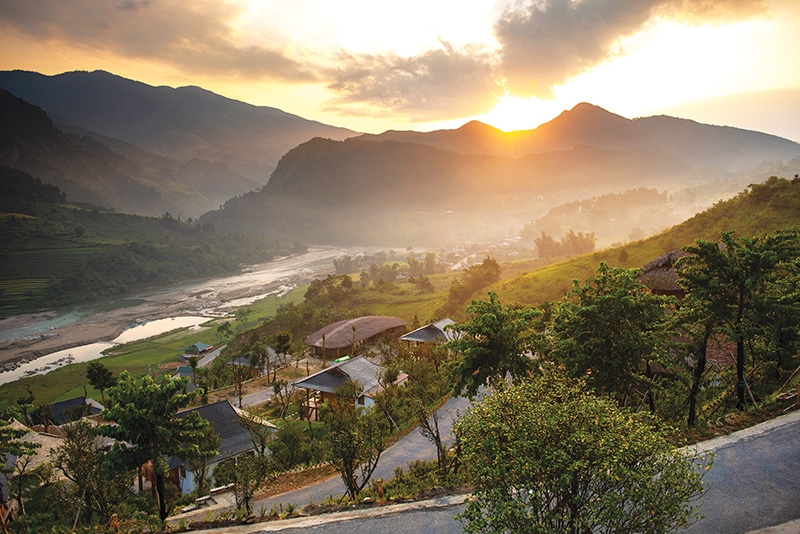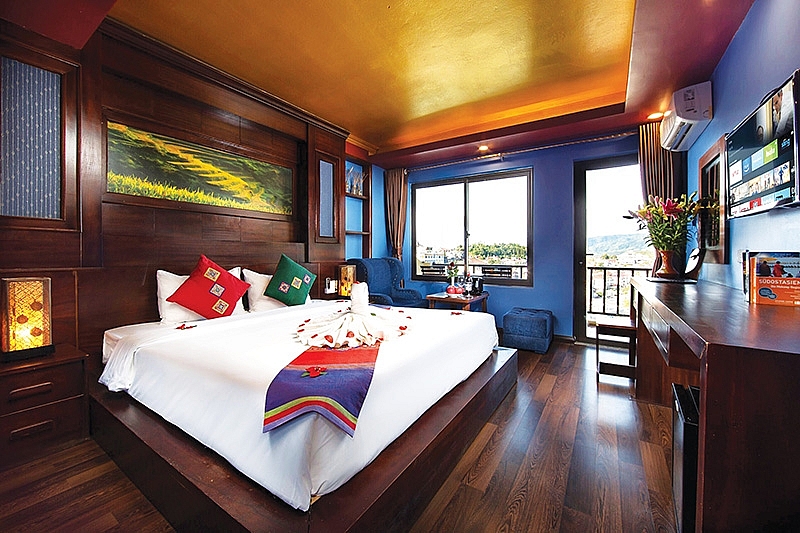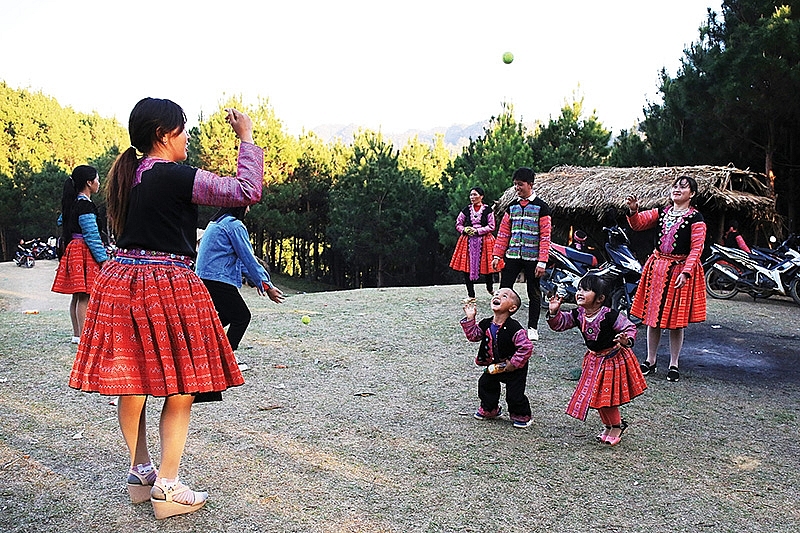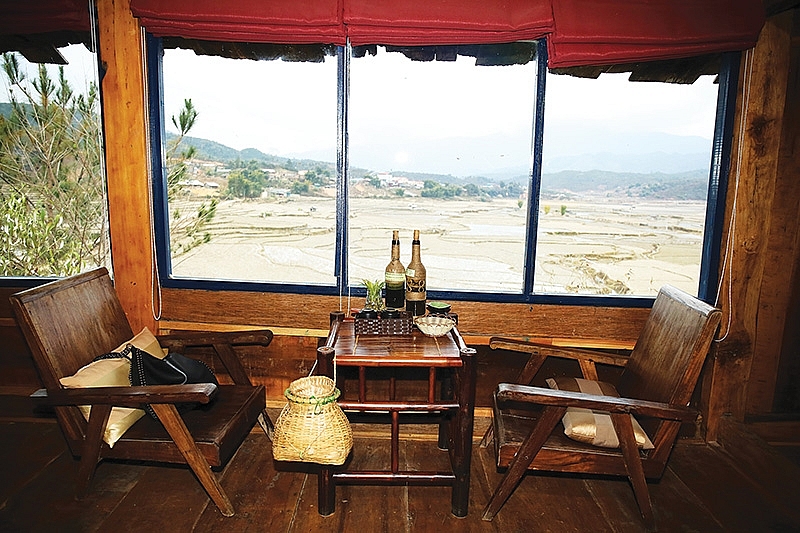Majestic mountains entice local community tourism
 |
| The mountainous region in the northern Vietnam offers an astonishing and unique scenery |
Five years ago, Mu Cang Chai used to be a neglected destination with a few services and accommodations. Despite the fame of the terraced fields, there are around 20,000 tourists per year coming to the area, most of whom are low-budget travellers.
However, in the past two years, Mu Cang Chai has continuously been listed among the top destinations voted by famous travel medias and most recently honoured as one of the ten best tourist attractions in the world in 2020 by CNBC.
Mu Cang Chai has become a magnet for investors planning to fund many high-end resort projects in the future. Accommodation and tourism services in the region have improved to respond to the increasing number of visitors with many homestay models for different budgets as well as high-end resorts being underconstruction.
Great wave of investors
Mu Cang Chai is just one of many examples of Vietnam’s rising tourism sector. Instead of financing famous destinations such as Danang, Hanoi, and Nha Trang, a lot of backers are now paying attention to new attractions or previously neglected ones. These areas possess great tourism potential thanks to their majestic natural landscapes, rich ecosystems, and deep history, as well as the beauty and cultural identities of ethnic minorities. The leading destination for large projects is Sapa, the famous tourist destination in Lao Cai province, followed by Hoa Binh, and recently Ha Giang, Cao Bang, and Yen Bai.
Sapa boasts many different types of accommodation and serves more than four million tourists per year. The constantly increasing numbers of passengers and the developed infrastructure have made Sapa become a well-known destination for investors such as Sun Group, Muong Thanh, Alphanam, and Silkpath among others. Sun Group, the biggest tourism investor in Sapa, has established many popular projects, including the Fansipan cable car system, a large-scale 5-star hotel complex in Muong Hoa Valley, another 5-star hotel called Mgallery, the Sapa cultural park, and so on. Muong Thanh Group marked its presence with the 3-star Muong Thanh Sapa Hotel, and Alphanam Group appeared with the JW Marriott Sapa Resort & Spa. Currently, Sapa has more than 30 more such resort projects being implemented.
Besides Sapa, Hoa Binh is also attracting many domestic and foreign investors to explore, research, and finance local tourism development. In addition to popular resorts such as Serena Kim Boi, Sol Bungalow, Mai Chau Hideaway, and other eco-tourism projects are already in the pipeline.
In Son La, a number of high-class resorts and destinations are being developed, including the pine forest at Ang Village, Moc Chau district, and eco-resorts close to Dai Yem Waterfall - all funded with large investments.
Along with these destinations, Ha Giang, Yen Bai, Cao Bang, and some other localities have also begun to initiate major tourism projects, change the appearance of the places while contributing to the local and national tourism sector.
Joint efforts
Along with attracting resources from large corporations, tourism in the Northern Highlands has also gradually changed thanks to the active participation of small businesses and individual households in the locality. These combined efforts focused on exploiting the area for small- and medium-sized community-based eco-tourism which has already become a trademark of the mountainous areas.
The highlights of these small types of tourism are the proximity to nature and indigenous elements, which enable visitors to experience the life of the local communities. Hoa Binh is a pioneer in promoting this type of tourism with more than 140 households participating in some form of community tourism.
Meanwhile, Lao Cai has built 13 community tourism sites, mainly in Sapa and Bac Ha districts. Each of them attracts a large number of tourists and generates impressive profit each year. So far, more than 120 households established community tourism projects. Most of them are concentrated in Nghia Lo town, Mu Cang Chai, and Yen Binh district. A number of other businesses in the province have also started pouring some funds into the local tourism sector, such as Thinh Dat JSC with its two high-end resort projects in Tu Le and Mu Cang Chai.
In addition to the participation of local businesses, a number of individuals from ethnic minorities have built their own eco-tourism areas and introduce their culture to visitors, thereby contributing to improving their own life as well as that of their families.
VIR would like to share some of the success stories with the desire to raise voices and expand their visibility as a good example of colourful tourism development in the mountainous areas.
| SAPARIS HOTEL & SAPA ECO-HOME-MOUNTAIN RETREAT Owner Lu A Tau, Sapa town, Lao Cai province
Lu A Tau graduated from the National University of Art Education and became a teacher. However, he quit the job only after one year to turn his attention towards tourism. He moved all the way to Ho Chi Minh City with the desire to find a new job. But after six months, the nostalgia for his family brought him back home and after a period of consideration, Tau saw Sapa as a potential market, so he decided to focus on studying English to apply for a job there. He said, “I borrowed my friends’ money, rented a room, and spent two months learning English. Right after that, I applied for an apprenticeship at a hotel and started my career in tourism. I quickly became a receptionist and six months later, I moved to a larger hotel and had the opportunity to experience many different positions which gave me the necessary experience before moving further.” Now, Tau is the owner of two hotels in Sapa, the 3-star Saparies Hotel in the centre of the town and the Sapa Eco-Home-Mountain Retreat located 2km from the town centre. Both hotels are operating well, with a stable monthly occupation rate and around 70-90 per cent of foreign visitors. After experiencing lots of difficulties, Tau desired to support and create jobs for the local H’Mong youth so that they could make a living right in their homeland – and now all his staff are local H’Mong people. Moreover, he is preparing for the establishment of a museum exhibiting H’Mong culture and lifestyle as well as training workshops for local people, both of which is believed to start in two or three months. “I have come a long way to get here. Now, I want to share and help young H’Mong to find work as a way to repay those who have helped me before,” said Tau. TRANG A SENH HOMESTAY Owner Trang A Senh, Hua Tat village, Van Ho district, Son La province
In the past, Trang A Senh was just a farmer busy with crops all year round. Three years ago, he became one of the pioneers in Hua Tat in the homestay business and now contributes to the sustainable development for the local economy. He went to Sapa, Ha Giang, and Hoa Binh to learn about community tourism when he first heard about it. In 2017, he started to use 5,000 square metres of his land for community tourism. His brand-new homestay launched just one month later and now welcomes 150 customers per month on average, mainly from Hanoi and distant provinces, as well as foreigners on weekends or holidays. When it gets really busy, all of his children are required to work with him, helping them gain more experience in the business. Trang A Senh homestay is the combination of two L-shaped chains of houses designed in an innovative traditional style with wooden pillars and walls, stone-paved floors, grass roofs, and modern facilities and amenities. Moreover, the wide area around the homestay also features entertainment spots for cultural activities. The highlight of the homestay is the pine forest close to the house, which is an ideal place for travellers to organise teambuilding activities, campfire nights, and photography or nature trips. Senh said that tourists coming to Hua Tam enjoy the traditional culture of the H’Mong people, the scenery, and the food, as well as the activities organised by the homestay. “We organise cultural exchange activities with boys and girls and build a performance troupe to perform traditional H’Mong dances, songs, and festivals. Tourists are very interested in participating in these programmes,” he explained. MU CANG CHAI ECOLODGE Owner Thao A Sang, Hua Khat village, Mu Cang Chai district, Yen Bai province
Located on a hill 20km from Mu Cang Chai town, Mu Cang Chai Ecolodge is currently the biggest community eco-tourism business in the area. It is owned by 62-year-old Thao A Sang, who also happens to be the former leader of Mu Cang Chai district. Explaining why he switched his business model and established the ecolodge, he said that agriculture is too hard for a retired man, so he decided to enter tourism in order to earn more income and create stable jobs for the youth in the village. He started the project in 2017, with support from one of his friends. Within months, Mu Cang Chai Ecolodge was officially launched with the first five H’Mong and Thai style houses. Now, the area has already nine of them and there will be six more in the future. According to Sang, these houses were bought from local people, then repaired and renovated while retaining traditional features. In order to show his love for the land he was born and raised in, Sang gave each house a simple name based on maize, rice, and tea - all of which are specific to the region. Mu Cang Chai has received a lot of positive feedback from visitors. During the crowded seasons, the ecolodge is always booked out and there has to be up to ten employees at the same time to guarantee a smooth service. Sang said, “We welcomed nearly 2,000 customers of which two-thirds were foreigners in 2019. Although the price for each room starts at $39, visitors often stay for two or three nights, mostly thanks to the peaceful atmosphere and the local experience we offer. Along with bringing us more money, the ecolodge also creates a bridge between locals and tourists, enabling them to learn more about the local lifestyle.” Interesting activities with locals here include gardening, farming, handicrafts, and even wedding ceremonies with ethnic minorities. |
What the stars mean:
★ Poor ★ ★ Promising ★★★ Good ★★★★ Very good ★★★★★ Exceptional
Related Contents
Latest News
More News
- Global alliance develops $1 billion AI data centre network in Vietnam (December 30, 2025 | 10:08)
- Businesses ramp up production as year-end orders surge (December 30, 2025 | 10:05)
- Vietnam’s GDP forecast to grow by 9 per cent in 2026 (December 29, 2025 | 08:29)
- Vietnam's top 500 value-creating enterprises announced (December 27, 2025 | 08:00)
- Three-way partnership unveiled to ease financing at Hong Hac City (December 24, 2025 | 14:13)
- PM orders investment model for North–South high-speed rail (December 22, 2025 | 17:43)
- First members of Danang International Finance Centre revealed (December 22, 2025 | 17:39)
- Securing capital and efficiency for Vietnam’s 2026-2030 growth ambitions (December 17, 2025 | 10:00)
- Driving double-digit growth through green and circular transformation in Vietnam (December 17, 2025 | 09:00)
- Vietnam bucking trend in the global M&A landscape (December 16, 2025 | 14:20)




 Tag:
Tag:




















 Mobile Version
Mobile Version